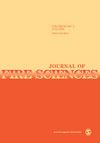氮作为一种环保型灭火剂,对飞机货机的消防安全起着重要作用
IF 1.9
4区 工程技术
Q2 ENGINEERING, MULTIDISCIPLINARY
引用次数: 1
摘要
货舱中的灭火系统是商用飞机安全的认证要求。根据《蒙特利尔议定书》,由于环境原因,哈龙的生产被禁止,使用将于2040年结束。这就需要另一种环保剂。氮作为药剂的定量分析确定了抑制系统的适用性。《最低性能标准》规定了代理商在四种情况下的资格鉴定程序——散装;集装箱装载;表面燃烧;气溶胶会爆炸。来自空中客车公司的经验来源、独立的计算流体动力学研究和小型杯形燃烧器测试表明,特定于飞机货物灭火的氮气适用性。介绍了氮气输送系统和实验装置。广泛的调试测试验证了仪器的可靠性。所有四个场景都是在克兰菲尔德大学的一个宽体飞机货舱的复制品中进行的。在氮气排放获得的低氧环境(11%)中,在没有任何爆炸或压力增加超过预期基线值的证据的情况下进行了气溶胶罐爆炸试验。表面燃烧方案已成功完成,并通过了最低性能标准标准。发现最高平均温度为220°C(极限-293°C)。所有场景都通过了最低性能标准,表明成功预防了B类火灾的再次点燃。同样,集装箱化和散装场景获得的结果通过了在指定时间内成功维持持续灭火的最低性能标准。集装箱装载火灾场景中的最高平均温度为210°C(极限343°C),散装装载场景中的最大平均温度为255°C(限制377°C。根据最低性能标准的格式,本文提出了额外的资格标准和系统设计。这项工作可以扩展到引入安全关键系统的标准测试,如发动机舱和锂离子火灾。本文章由计算机程序翻译,如有差异,请以英文原文为准。
Nitrogen as an environmentally friendly suppression agent for aircraft cargo fire safety
Fire suppression systems in cargo compartments are a certification requirement for commercial aircraft safety. Halon production was banned and usage ends in 2040 according to Montreal Protocol for environmental reasons. This necessitates an alternative environmentally friendly agent. Quantitative analysis of nitrogen as agent established suitability of the suppression system. The Minimum Performance Standards specifies the qualification procedure of an agent through four scenarios – bulk load; containerised load; surface burning; and aerosol can explosion. Empirical sources from Airbus, independent computational fluid dynamics studies and small-scale cup-burner tests indicate suitability of nitrogen specific to aircraft cargo fire suppression. The nitrogen delivery system and the experimental apparatus are presented. Extensive commissioning tests verified instrumentation reliability. All the four scenarios were conducted at Cranfield University, in a replica of a wide-body aircraft cargo compartment. In a reduced oxygen environment (11%) obtained with nitrogen discharge, the aerosol can explosion tests were performed without any evidence of explosion or pressure increase beyond the expected baseline value. The surface burning scenario was completed successfully and passed the Minimum Performance Standard criteria. The maximum average temperature was found to be 220°C (limit – 293°C). All the scenarios passed the Minimum Performance Standard criteria for indicating successful prevention of Class B fire re-ignition. Similarly, the containerised and bulk-load scenarios obtained results that passed the Minimum Performance Standard criteria for successfully maintaining continued fire suppression for a specified period of time. The maximum average temperature in containerised-load fire scenario was found to be 210°C (limit – 343°C) and in bulk-load scenario was 255°C (limit – 377°C). Additional qualification criteria and system design are presented in this article according to the Minimum Performance Standard format. This work can be extended to introduce standard testing for safety critical systems, such as engine bay and lithium-ion fires.
求助全文
通过发布文献求助,成功后即可免费获取论文全文。
去求助
来源期刊

Journal of Fire Sciences
工程技术-材料科学:综合
CiteScore
4.00
自引率
0.00%
发文量
14
审稿时长
2.5 months
期刊介绍:
The Journal of Fire Sciences is a leading journal for the reporting of significant fundamental and applied research that brings understanding of fire chemistry and fire physics to fire safety. Its content is aimed toward the prevention and mitigation of the adverse effects of fires involving combustible materials, as well as development of new tools to better address fire safety needs. The Journal of Fire Sciences covers experimental or theoretical studies of fire initiation and growth, flame retardant chemistry, fire physics relative to material behavior, fire containment, fire threat to people and the environment and fire safety engineering. This journal is a member of the Committee on Publication Ethics (COPE).
 求助内容:
求助内容: 应助结果提醒方式:
应助结果提醒方式:


